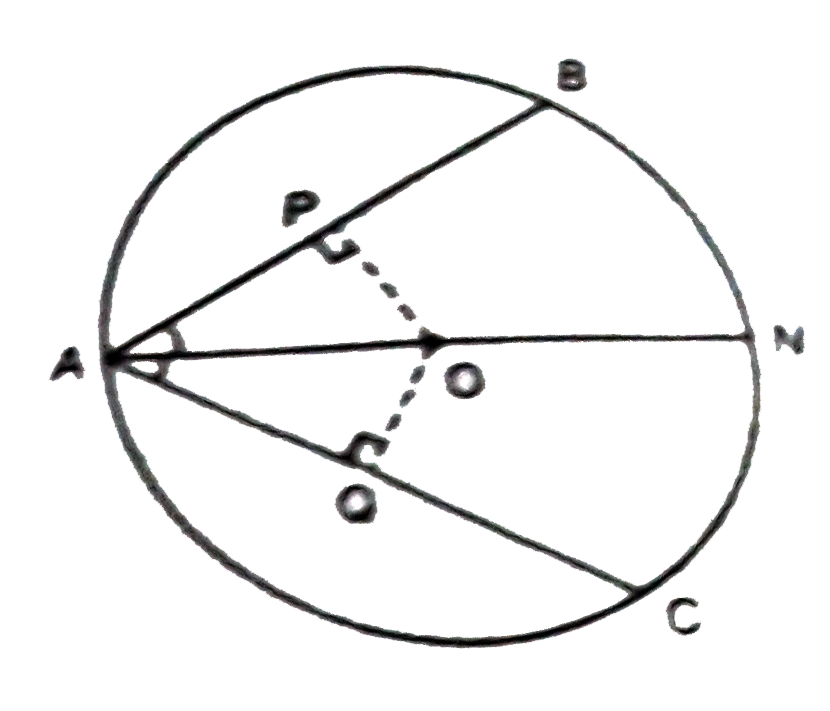The curve for which the length of the normal is equal to the length of the radius vector is/are (a) circles (b) rectangular hyperbola (c) ellipses (d) straight lines
To find the curves for which the length of the normal is equal to the length of the radius vector, we will follow these steps:
Step 1: Define the Length of the Normal and Radius Vector
The length of the normal n to a curve at a point is given by:
n=y√1+(dydx)2
The length of the radius vector r from the origin to a point (x,y) is given by:
r=√x2+y2
Step 2: Set the Lengths Equal
According to the problem, we set the lengths equal:
y√1+(dydx)2=√x2+y2
Step 3: Square Both Sides
To eliminate the square roots, we square both sides:
y2(1+(dydx)2)=x2+y2
Step 4: Expand and Rearrange
Expanding the left side gives:
y2+y2(dydx)2=x2+y2
Subtract y2 from both sides:
y2(dydx)2=x2
Step 5: Simplify the Equation
This can be simplified to:
(dydx)2=x2y2
Taking the square root gives:
dydx=±xy
Step 6: Separate Variables
We can separate the variables:
ydy=±xdx
Step 7: Integrate Both Sides
Integrating both sides, we have:
∫ydy=±∫xdx
This results in:
y22=±x22+C
Step 8: Rearrange the Equation
Multiplying through by 2 yields:
y2=±x2+2C
This can be rearranged to:
y2−x2=2C(Rectangular Hyperbola)
or
y2+x2=2C(Circle)
Conclusion
Thus, the curves for which the length of the normal is equal to the length of the radius vector are:
- Rectangular Hyperbola: y2−x2=2C
- Circle: y2+x2=2C
Final Answer
The correct options are:
- (a) Circles
- (b) Rectangular Hyperbola
The length of the normal n to a curve at a point is given by:
n=y√1+(dydx)2
The length of the radius vector r from the origin to a point (x,y) is given by:
r=√x2+y2
According to the problem, we set the lengths equal:
y√1+(dydx)2=√x2+y2
To eliminate the square roots, we square both sides:
y2(1+(dydx)2)=x2+y2
Expanding the left side gives:
y2+y2(dydx)2=x2+y2
Subtract y2 from both sides:
y2(dydx)2=x2
This can be simplified to:
(dydx)2=x2y2
Taking the square root gives:
dydx=±xy
We can separate the variables:
ydy=±xdx
Integrating both sides, we have:
∫ydy=±∫xdx
This results in:
y22=±x22+C
Multiplying through by 2 yields:
y2=±x2+2C
This can be rearranged to:
y2−x2=2C(Rectangular Hyperbola)
or
y2+x2=2C(Circle)
Thus, the curves for which the length of the normal is equal to the length of the radius vector are:
- Rectangular Hyperbola: y2−x2=2C
- Circle: y2+x2=2C
The correct options are:
- (a) Circles
- (b) Rectangular Hyperbola
Similar Questions
Find the curve for which the length of normal is equal to the radius vector.
View SolutionFind the curves for which the length of normal is equal to the radius vector.
View SolutionThe curve for which the ratio of the length of the segment intercepted by any tangent on the Y-axis to the length of the radius vector is constant (k), is
View SolutionThe length of normal at any point to the curve, y=ccosh(xc) is
View SolutionThe curve in the first quadrant for which the normal at any point (x,y) and the line joining the origin to that point form an isosceles triangle with the x-axis as base is (a) an ellipse (b) a rectangular hyperbola (c) a circle (d) None of these
View SolutionProve that the chords inclined on the same angle to the radius or diameter of a circle are equal in length.

View SolutionFor a curve (length of normal)^2/(length of tangent)^2 is equal to
View SolutionThe line y=mx+c will be a normal to the circle with radius r and centre at (a,b) if
View SolutionA circle touches the line L and the circle C1 externally such that both the circles are on the same side of the line, then the locus of centre of the circle is (a) Ellipse (b) Hyperbola (c) Parabola (d) Parts of straight line
View SolutionThe locus of the centre of a circle which cuts a given circle orthogonally and also touches a given straight line is (a) circle (c) parabola (b) line (d) ellipse
View Solution
